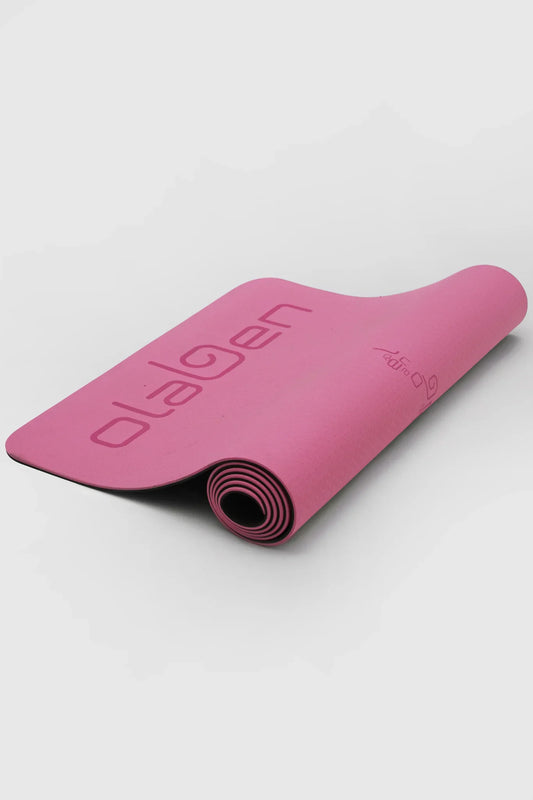Acro Yoga blends the mindfulness of yoga with the strength and playfulness of acrobatics, creating a practice built on balance, trust, and connection. Beyond improving flexibility, coordination, and body awareness, it also strengthens communication and partnership whether you’re practicing with a friend, partner, or even a new teammate. Whether you’re completely new to yoga or simply curious about those floating, flying poses you’ve seen online, Acro Yoga offers an energizing and empowering way to move. Olaben provides everything you need to know before you lift off into your first practice.
What is Acro Yoga?
Acro Yoga is a playful blend of yoga, acrobatics, and partner balance work. If you’ve ever seen someone lying on their back while lifting another person into the air, that’s Acro Yoga in action. Most beginners start with L-basing, where one partner acts as the base on the ground and the other becomes the flyer supported on their legs. It may look intimidating, but the practice is surprisingly accessible and offers endless variations once you get the basics down.
More than a physical workout, Acro Yoga is built on trust, communication, and connection. Practitioners rely on each other for stability, safety, and flow, creating a strong sense of community. And while it delivers strength, balance, and body awareness, many people stay because of the unique, floating sensation that makes the practice feel both energizing and addictive.
What Acro Yoga is not is a quiet, restorative yoga class. Expect laughter, movement, conversation, and the occasional wobble. But if you’re open to trying something dynamic, social, and unexpectedly fun, Acro Yoga offers an experience unlike anything else on the mat.

Popular Acro Yoga Poses
|
Level |
Main Focus |
Roles Involved |
What You’ll Learn |
|
|
Bird Pose |
Beginner |
Balance & stability |
Base + Flyer |
Feeling of “flying,” core engagement, foundational L-basing skills |
|
Throne Pose |
Beginner–Intermediate |
Upright balance |
Base + Flyer |
Center of gravity control, seated balance, partner coordination |
|
Backbird Pose |
Beginner |
Chest opening & trust |
Base + Flyer |
Heart-opening stretch, relaxation, building trust and communication |
|
Shoulderstand Pose |
Intermediate |
Inversion & alignment |
Base + Flyer + Spotter |
Body alignment, inversion control, stronger core stability |
Bird Pose
Bird Pose is a classic beginner-friendly Acro Yoga pose that combines balance, trust, and core strength. Many people have experienced a version of it as kids when someone lifted them on their feet and pretended they were flying! In Acro Yoga, this pose teaches you how to connect with a partner, stabilize your core, and safely experience the thrill of “flying.”

Step 1: Setup
Base: Lie on your back with legs lifted straight toward the ceiling and arms relaxed by your sides. This is your foundation.
Flyer: Stand close to the base’s hips, allowing the base’s hands or feet to reach you comfortably.
Spotter: Stand nearby with knees slightly bent, ready to assist and support the flyer if needed.
Step 2: Connection
Base: Extend your arms upward and align your feet with the flyer’s hips. Ensure the soles of your feet (especially the heels) connect firmly to the flyer’s hip bones.
Flyer: Reach your arms forward, keeping them straight, thumbs pointing toward each other. Engage your core and stay tall.
Spotter: Place your hands lightly near the flyer’s hips, prepared to guide or catch them if balance shifts.
Step 3: Lift Preparation
Base: Bend your knees slightly to tip the flyer’s weight onto your feet. Reach to connect hands with the flyer as they lower into position.
Flyer: Lean into the base’s support while keeping your body straight and strong. Grab the base’s hands without bending at the hips.
Spotter: Follow the flyer’s hips closely, staying ready to support or prevent a fall.
Step 4: Lift into Bird Pose
Base: Straighten your legs and flex your ankles, lifting the flyer into the air. Keep arms straight and feet aligned over the hips for a stable base.
Flyer: Maintain a plank-like shape with arms straight under the shoulders. Engage your core for stability.
Spotter: Stay close to the flyer’s hips and be ready to intervene if anything shifts.
Step 5: Exiting the Pose
Base: Slowly bend your knees and lower the flyer’s feet to the ground, guiding them upright.
Flyer: Release the base’s hands once your feet touch the ground and stand tall.
Spotter: Continue supporting until the flyer is safely standing on the ground.
Throne Pose
Throne Pose is a beginner-friendly Acro Yoga posture that offers comfort for the flyer while still building trust, balance, and coordination. Unlike some other poses, the flyer’s hands are free, making it feel stable and enjoyable once you get the hang of it.
Step-by-step Instructions for Throne Pose

Step 1: Setup & Hand Connection
Base: Bend your knees deeply and place your feet on the inner thighs of the flyer, roughly where the inseam of pants would be. Connect hands with the flyer to create a secure grip.
Flyer: Stand behind the base’s hips in a wide-legged squat and lean forward to meet the base’s hands. Engage your core and keep your weight centered.
Step 2: Weight Transfer
Base: Once the flyer leans forward, straighten your legs slightly while keeping arms straight to support the flyer’s upper body.
Flyer: Lean into the base’s hands and tuck your knees toward your chest as the base’s feet push into your thighs for lift.
Spotter: Stand close to the side of the base, hands near the flyer’s hips, ready to catch or support if balance shifts.
Step 3: Locking Position
Base: Bend your knees slightly while keeping arms extended to lift the flyer’s torso upright.
Flyer: Cross your shins over the base’s shins and wrap your feet around the base’s legs to lock into position securely.
Spotter: Stay alert and prepared to assist if the flyer starts to wobble.
Step 4: Throne Pose!
Base: Release the flyer’s hands and straighten your legs fully, providing stable support from below.
Flyer: Sit upright, letting go of the base’s hands, maintaining balance through your core and legs.
Spotter: Continue supporting near the flyer’s hips to prevent falls, only stepping back once the pose feels stable.
Step 5: Exiting Throne Pose
Base: Bend your knees and reconnect hands with the flyer. Gently guide the flyer back over your hips to lower them safely to the ground.
Flyer: Unwrap your ankles and place your feet on the floor, returning to a standing position.
Spotter: Maintain spotting until the flyer is safely on the ground.
Backbird Pose
Backbird Pose is a beginner-friendly Acro Yoga posture where the flyer lies facing upward on the base. This pose emphasizes trust, as the flyer cannot see the ground below, and also provides a supported backbend, making it a perfect stretch after long hours of sitting.
Step-by-step Instructions for Backbird Pose

Step 1: Setup
Base: Lie on your back and lift your legs straight into the air.
Flyer: Stand close to the base’s hips, facing away from them with your back toward the base.
Spotter: Stand nearby, prepared to assist or support the flyer’s shoulders and hips.
Step 2: Connection
Base: Flex your ankles and slightly bend your knees.
Flyer: Reach behind to grab the base’s ankles securely, thumbs inward and fingers wrapped around the outside of the ankles.
Spotter: Place one hand across the flyer’s belly and the other near the top of the shoulders to stabilize and prevent tipping.
Step 3: Positioning
Base: Place your feet firmly on the flyer’s sacrum (just below the lower back) for full support.
Flyer: Arch your back and lean into the base’s feet, distributing your weight evenly.
Spotter: Stay alert to block any lateral or backward falls.
Step 4: Backbird Lift
Base: Bend your knees slightly to bring the flyer’s weight over you, then extend your legs straight upward. For extra stability, you can place your hands on the flyer’s shoulders.
Flyer: Continue to arch and lean backward over the base’s support, maintaining a strong core.
Spotter: Keep close to the flyer’s shoulders and hips, ready to catch or guide if balance shifts.
Step 5: Exiting Backbird Pose
Base: Slowly bend your knees, bringing the flyer’s feet toward the ground. Then gently straighten your legs to help lift their torso upright.
Flyer: Bend your knees, place your feet on the floor, and push into the base’s ankles to return to standing.
Spotter: Continue spotting until the flyer is safely upright on the ground.
Shoulderstand Pose
Shoulderstand Pose in Acro Yoga is an intermediate-level inversion where the flyer is fully upside down. This variation keeps the flyer closer to the ground for easier control and safety, making it perfect for those new to inverted poses. Communication between base, flyer, and spotter is key to a smooth, safe experience.
Step-by-step Instructions for Shoulderstand Pose

Step 1: Base Setup & Flyer Position
Base: Lie on your back with bent legs, feet hip-width apart and close to your hips. Lift your arms straight up toward the ceiling.
Flyer: Stand with feet on either side of the base’s belly, legs wide for stability.
Spotter: Position yourself near the base’s head, ready to assist.
Step 2: Connection & Alignment
Base: Place your hands on the flyer’s shoulders, fingers extending onto the upper back, elbows straight.
Flyer: Fold forward at the hips, reach between your legs, and grasp the base just below the knees. Place shoulders into the base’s hands for support.
Spotter: Stay close to the flyer’s hips, ready to stabilize or intervene if balance shifts.
Step 3: Lifting into Shoulderstand
Base: Keep arms bone-stacked and elbows straight, providing a stable lift.
Flyer: Step one foot at a time onto the base’s knees, round the upper back slightly, and lift your hips upward. Maintain core engagement and weight distribution over the base’s support.
Spotter: Be prepared to hold the flyer’s hips or guide them safely if anything goes wrong.
Step 4: Shoulderstand Pose!
Base: Maintain bone-stacked alignment, fingers pressing into the flyer’s back for extra support.
Flyer: Straighten your legs, lifting hips over shoulders, and press firmly into the base’s thighs. Extend legs upward and slightly outward for balance.
Spotter: Stay close to the flyer’s hips at all times to stabilize or safely guide them down if needed.
Step 5: Exiting Shoulderstand Pose
Base: Gently push hands toward your feet to lower the flyer.
Flyer: Bend at the hips, place feet wide on either side of the base, and return to the ground safely.
Spotter: Continue supporting the hips until the flyer is fully standing.
Tip for Flyers: The step onto the base’s knees can feel tricky. Lean your weight into your shoulders and upper back, pressing into the base’s hands to maximize support and stability.
Safety Tips when Practicing Acro Yoga
- Wear the right clothing: Opt for activewear, like leggings and fitted tops, that stretch with your movements. Form-fitting clothes prevent slipping and allow the base and flyer to connect safely. Avoid baggy sleeves or loose pants that could get tangled during lifts.
- Use proper equipment: Always practice on a yoga mat or cushioned surface to reduce impact in case of falls. Beginners can add props like blocks or pillows for extra support. Make sure the area around you is clear of obstacles, furniture, or hard surfaces.
- Stay hydrated: Acro Yoga can be physically demanding. Keep water nearby and take small sips between poses to maintain focus, energy, and muscle performance.
- Warm up properly: Stretch your wrists, shoulders, core, hips, and legs before practice. A thorough warm-up reduces the risk of strains and prepares your body for lifts, balances, and inversions.
- Communicate constantly: Flyers, bases, and spotters should talk through each step of the pose. Check that everyone feels ready, aligned, and comfortable before lifting or transitioning. Clear communication builds trust and reduces accidents.
- Start slow and progress gradually: Begin with beginner-friendly poses such as Bird, Throne, or Backbird. Only attempt Shoulderstand or advanced inversions once you feel stable and have practiced with a spotter. Consistent, gradual progression prevents injuries.
- Listen to your body: Pay attention to discomfort, dizziness, or pain. Stop immediately if something feels off. Focus on controlled movements rather than speed or showing off, your body will thank you, and your practice will be safer.
- Spotters are essential: Always have a spotter, especially for beginners or new moves. They provide support, help maintain balance, and ensure safe exits from poses.
>> Read more: Yoga Equipment for Beginners: Guide to Clothes & Props
When it comes to supporting your Acro Yoga practice, having the right gear can make all the difference. Olaben offers a wide range of products designed for yoga and movement, from comfortable, stretchable yoga outfits like leggings, tops, and sports bras, to essential accessories such as yoga mats, blocks, straps, and water bottles. Whether you’re just starting out or advancing to more challenging poses, Olaben provides everything you need to stay safe, supported, and stylish on your mat. Their high-quality gear ensures that you can focus on your practice, build confidence, and enjoy every moment of your Acro Yoga journey.












